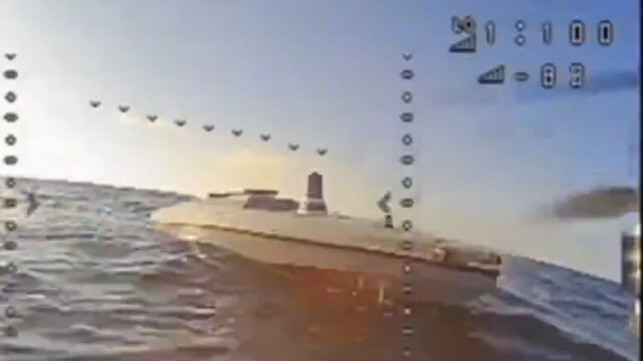Video: Russian FPV Drone Destroys Ukrainian Boat Drone

Russian military forces appear to have released the first known footage of a first-person-view (FPV) drone attack on a unmanned surface vehicle (USV). If confirmed, it would be a logical outcome for two new types of low-cost weapon: the remote-controlled suicide drone versus the remote-controlled suicide boat.
FPV drones were originally designed for low-cost recreational use. On the battlefield in Ukraine, they have been armed with explosives and turned into guided weapons - potent and deadly, but vulnerable to jamming, as the drone's guidance depends on a radio connection with a human operator.
The new footage was taken from the aerial drone's perspective, and shows the quadcopter zooming in low on approach to a drifting surface vessel, identical in appearance to a Ukrainian Magura V5 unmanned attack boat. The video ends at the time of apparent impact.
Possibly the first documented case of a strike with FPV drone targeting an unmanned surface vehicle (USV).
— Status-6 (Military & Conflict News) (@Archer83Able) May 29, 2024
The strike was carried by Russian forces on a Ukrainian USV in the Black Sea area. pic.twitter.com/S3dTqeNnxv
Critics quickly noted that the vessel was not moving at the time of the encounter, and was minimally visible from the drone's perspective on approach - potential signs of a staged video or a training exercise. However, at least one Russian military commentator suggested that FPV drones are an important part of Russia's "final" defensive arrangement to fend off Ukrainian attack boats.
"We have the final scheme for countering USVs, [which] includes optical detection from large UAVs and ship radars, or from shore," commented the RusEngineer Telegram channel. "[Then] get them from the coast and ships using helicopters, airborne guns or aircraft with cluster bombs, then at a distance of up to 10-15 kilometers from a ship or shore with FPV drones."
About 15 Russian naval vessels have been damaged or destroyed by Ukraine's drones and missiles since the start of the full-scale invasion in 2022, including two warships sunk in a month's time by drone boats earlier this year. Mass nighttime attacks have proven effective at penetrating Russian defenses, even at long range from Ukraine.
The problem has attracted high-level attention from Russian defense officials, who have increased the resources dedicated to countering the new high-tech threat. Russian sources have also released videos of attack helicopters hunting and destroying the small surface vessels at sea, before they reach the target zone.
Footage from Russian Ka-29 helicopter engaging Ukrainian USV with R-73 air-to-air heat-seeking missiles. https://t.co/ONS0uacMKB pic.twitter.com/E6zGjmCbuv
— Clash Report (@clashreport) May 6, 2024
The next front in the Black Sea drone wars may be underwater. Ukrainian officials have suggested switching to submersible drones in order to evade Russia's strengthened defenses.
"The enemy is adapting, and we must also adapt. A modern war is a war of technologies. Whoever wins in the technological sense will have victory," Ukrainian Navy chief Vice Admiral Oleksiy Neizhpapa told Sky News.
